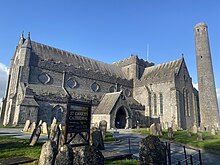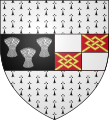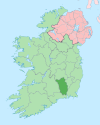Portal:County Kilkenny
The County Kilkenny Portal
County Kilkenny (Irish: Contae Chill Chainnigh) is a county in Ireland. It is in the province of Leinster and is part of the Southern Region. It is named after the city of Kilkenny. Kilkenny County Council is the local authority for the county. At the 2022 census the population of the county was 103,685. The county was based on the historic Gaelic kingdom of Ossory (Osraighe), which was coterminous with the Diocese of Ossory. (Full article...)
Selected articles

Kilkenny (Irish: Cill Chainnigh [ˌciːl̠ʲ ˈxan̠ʲəj], meaning 'church of Cainnech') is a city in County Kilkenny, Ireland. It is located in the South-East Region and in the province of Leinster. It is built on both banks of the River Nore. The 2022 census gave the population of Kilkenny as 27,184, the thirteenth-largest urban center in Ireland.
Kilkenny is a tourist destination, and its environs include historic buildings such as Kilkenny Castle, St Canice's Cathedral and round tower, Rothe House, Shee Alms House, Black Abbey, St. Mary's Cathedral, The Tholsel, St. Francis Abbey, Grace's Castle, and St. John's Priory. Kilkenny is also known for its craft and design workshops, the Watergate Theatre, public gardens and museums. Annual events include Kilkenny Arts Festival, the Cat Laughs comedy festival and music at the Kilkenny Roots Festival.
Kilkenny began with an early 6th-century ecclesiastical foundation within the Kingdom of Ossory. Following the 12th-century Norman invasion of Ireland, Kilkenny Castle and a series of walls were built to protect the burghers of what became a Norman merchant town. William Marshall, Lord of Leinster, gave Kilkenny a charter as a town in 1207. By the late 13th century, Kilkenny was under Hiberno-Norman control. The Statutes of Kilkenny, passed at Kilkenny in 1367, aimed to curb the decline of the Hiberno-Norman Lordship of Ireland. In 1609, King James I of England granted Kilkenny a Royal Charter, giving it the status of a city. Following the Irish Rebellion of 1641, the Irish Catholic Confederation, also known as the "Confederation of Kilkenny", was based in Kilkenny and lasted until the Cromwellian conquest of Ireland in 1649. From 1840 onwards, Kilkenny has not been administered as a city under local government law, but the Local Government Reform Act 2014 provides for "the continued use of the description city". (Full article...)
Selected history articles

The history of Kilkenny (from Irish Cill Chainnigh 'Cell or church of Cainnech/Canice') began with an early sixth-century ecclesiastical foundation, this relates to a church built in honour of St. Canice, now St. Canice's Cathedral and was a major monastic centre from at least the eighth century. The Annals of the Four Masters recorded the first reference Cill Chainnigh in 1085. Prehistoric activity has been recorded suggesting intermittent settlement activity in the area in the Mesolithic and Bronze Age. Information on the history of Kilkenny can be found from newspapers, photographs, letters, drawings, manuscripts and archaeology. Kilkenny is documented in manuscripts from the 13th century onwards and one of the most important of these is Liber Primus Kilkenniensis.
The Kings of Ossory had residence around Cill Chainnigh. The seat of diocese of Kingdom of Osraige was moved from Aghaboe to Cill Chainnigh. Following Norman invasion of Ireland, Richard Strongbow, as Lord of Lenister, established a castle near modern-day Kilkenny Castle. William Marshall began the development of the town of Kilkenny and a series of walls to protect the burghers. By the late thirteenth century Kilkenny was under Norman-Irish control. The original ecclesiastical centre at St. Canice's Cathedral became known as Irishtown and the Anglo-Norman borough inside the wall came to be known as Hightown. (Full article...)
Selected landmarks articles

St Canice's Cathedral (Irish: Ardeaglais Naomh Cainneach, pronounced [ˈaːɾˠd̪ˠˌaɡlˠəʃ n̪ˠiːw ˈkan̠ʲəx]), also known as Kilkenny Cathedral, is a cathedral of the Church of Ireland in Kilkenny city, Ireland. It is in the ecclesiastical province of Dublin. Previously the cathedral of the Diocese of Ossory, it is now one of six cathedrals in the United Dioceses of Cashel and Ossory. (Full article...)
Selected geography articles
The barony of Shillelogher (Irish: Síol Fhaolchair, meaning 'territory of the Descendants of Fáelchar') is a barony in the west of County Kilkenny, Ireland. The barony is 36,684 acres (148.45 km2) in size. It is one of 12 baronies in County Kilkenny. There are 19 civil parishes in Shillelogher, made up of 109 townlands. The chief town is Bennettsbridge. Shillelogher lies at the centre of the county, with the baronies of Crannagh and Kilkenny to the north (whose chief towns are Freshford and Kilkenny, and the barony of Gowran to the east (whose chief towns is Gowran). It is borders County Tipperary to the west. The N76 road bisects the barony. The river Nore flows through the barony. Danesfort Church is located in Shillelogher. (Full article...)
Moneenroe (from Irish An Móinín Rua, meaning 'the little red bog') is a townland, electoral division and village in north County Kilkenny, Ireland. It is located in the province of Leinster along the N78 road about 21 kilometres (13 mi) from Kilkenny city in the south-east of the island of Ireland. , the population of Moneenroe was 722. (Full article...)
The River Suir (/ʃʊər/ SHOOR; Irish: an tSiúr [ənʲ ˈtʲuːɾˠ] or Abhainn na Siúire [ˌəun̠ʲ n̪ˠə ˈʃuːɾʲə]) is a river in Ireland that flows into the Atlantic Ocean through Waterford after a distance of 185 kilometres (115 mi). The catchment area of the Suir is 3,610 km2. Its long term average flow rate is 76.9 cubic metres per second (m3/s), about twice the flow of either the River Barrow (37.4 m3/s) or the River Nore (42.9 m3/s) before these join, but a little less than the Barrow's flow when it meets the Suir 20 km downstream (over 80 m3/s). (Full article...)

Jenkinstown Park is a park in County Kilkenny, Ireland. It is situated off the N78 road about 10 km north of the city of Kilkenny and 11 km south of Castlecomer. (Full article...)
Selected quotation
"Fire without smoke, Air without fog, Water without mud, Land without bog."
|
— Unknown, circa 17th Century |
Selected Did you know

- ... that Henry Shefflin (pictured) has won seven All-Ireland titles?
- ...Kjarvalr Írakonungr, a figure in the Norse sagas who appears as an ancestor of many prominent Icelandic families, is identified with Cerball mac Dúnlainge. (Full article...)
Selected slideshow image
Selected biography articles
Mildred Anne Butler RA RWS (11 January 1858 – 11 October 1941) was an Irish artist, who worked in watercolour and oil of landscape, genre and animal subjects. Butler was born and spent most of her life in Kilmurry, Thomastown, County Kilkenny and was associated with the Newlyn School of painters.
Mildred Anne's en plein air style is dominated by the theme of nature and reflects scenes of domesticity around the family home in Kilmurry. She achieved distinction in her lifetime and exhibited in major galleries in Ireland and England. Among her patrons were Queen Mary of Teck and Louis IV, Grand Duke of Hesse. (Full article...)
John O'Donovan (Irish: Seán Ó Donnabháin; 25 July 1806 – 10 December 1861), from Atateemore, in the parish of Kilcolumb, County Kilkenny, and educated at Hunt's Academy, Waterford, was an Irish language scholar from Ireland. (Full article...)
Thomas "Tomm" Moore (born 7 January 1977) is an Irish filmmaker, animator, illustrator and comics artist. He co-founded Cartoon Saloon with Nora Twomey and Paul Young, an animation studio and production company based in Kilkenny, Ireland. His first three feature films, The Secret of Kells (2009), co-directed with Nora Twomey, Song of the Sea (2014) and Wolfwalkers (2020), co-directed with Ross Stewart, have received critical acclaim and were all nominated for the Academy Award for Best Animated Feature. (Full article...)
Deborah Alcock (1835– 15 January 1913) was a late-Victorian author of historical fiction focused on religious, evangelical themes. (Full article...)
Selected sport articles
The 2009 All-Ireland Senior Hurling Championship Final was a hurling match played on 6 September 2009 in Croke Park, Dublin, between Kilkenny and Tipperary. It was the first time the two teams had met in the All-Ireland final since 1991. Kilkenny's win was their fourth in a row, an accomplishment last matched by Cork between 1941 and 1944.
Kilkenny's victory gave them a record seventh title of the decade and a record 18th consecutive Championship win. Following the match, Kilkenny manager Brian Cody announced details of the release of his autobiography, Cody. Kilkenny hurler Henry Shefflin was named as the sport's Opel GPA Player of the Month for August after the win; Shefflin contributed 1–14 of Kilkenny's score in the final. Shefflin was named on The Etihad 125 Dream Team before the final. He also claimed his ninth All Star Award. (Full article...)
Related portals
Associated Wikimedia
The following Wikimedia Foundation sister projects provide more on this subject:
-
Commons
Free media repository -
Wikibooks
Free textbooks and manuals -
Wikidata
Free knowledge base -
Wikinews
Free-content news -
Wikiquote
Collection of quotations -
Wikisource
Free-content library -
Wikiversity
Free learning tools -
Wikivoyage
Free travel guide -
Wiktionary
Dictionary and thesaurus





























































